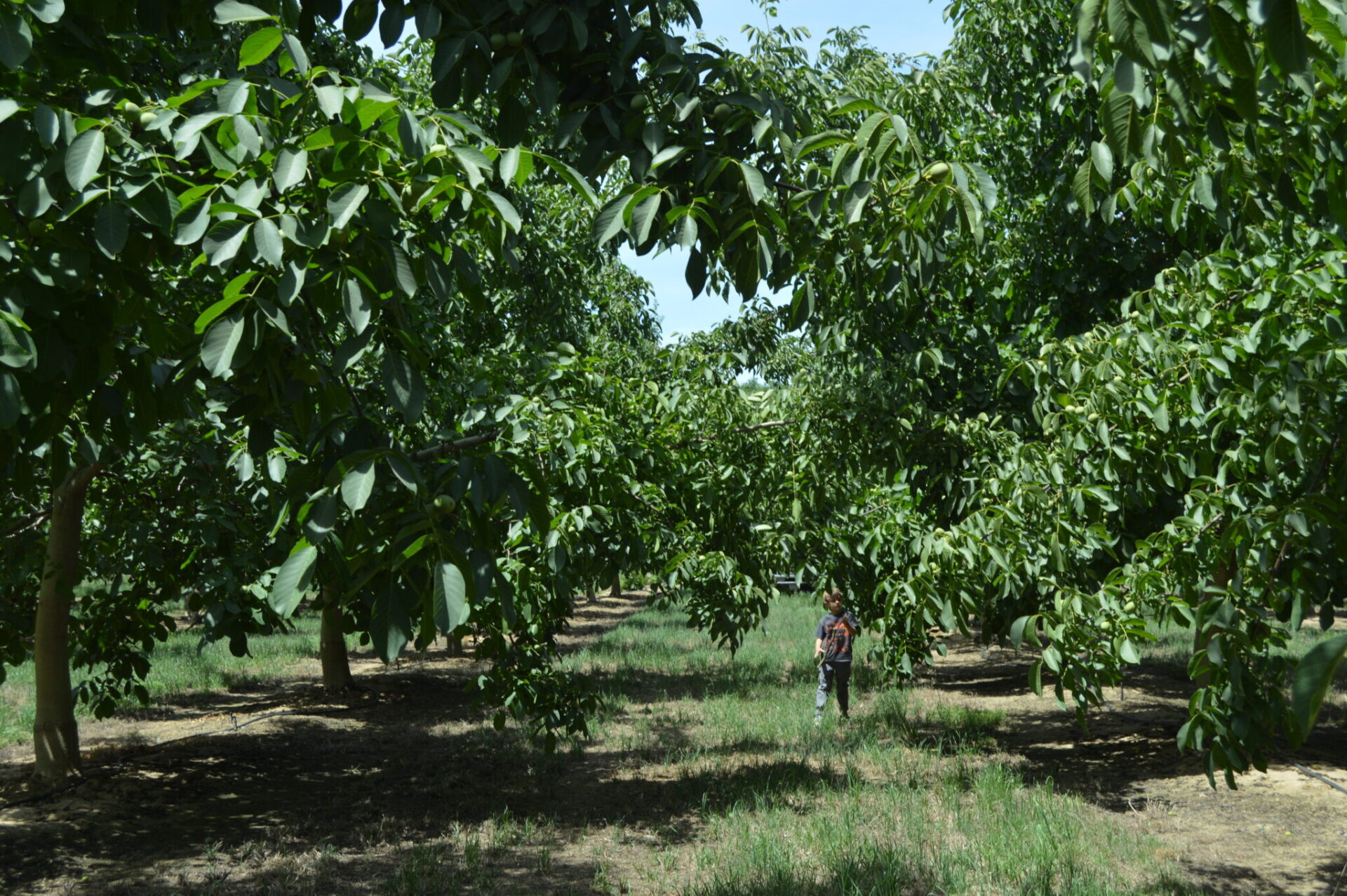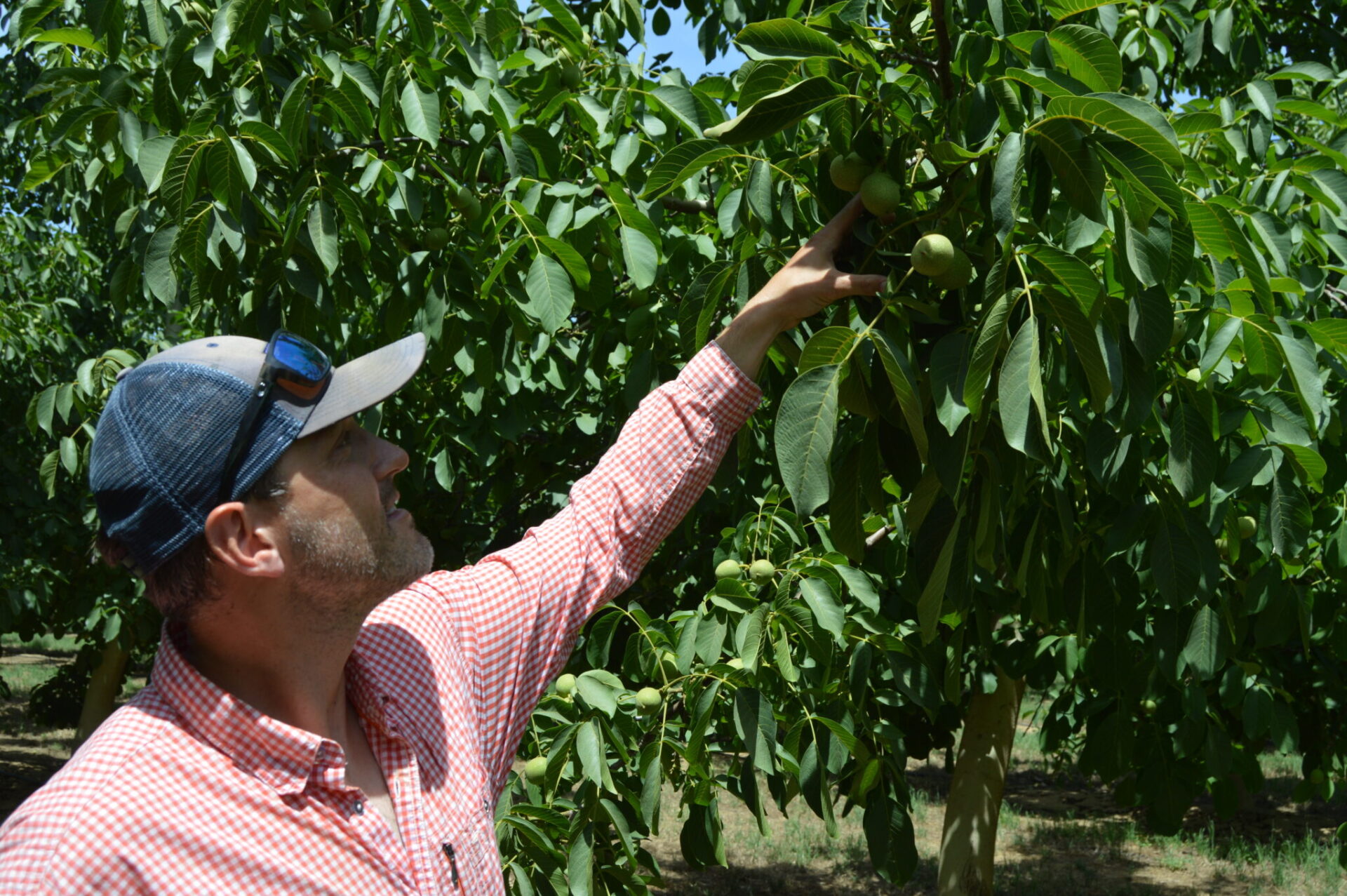
For walnut grower Davin Norene, the new UC Davis walnut variety Wolfskill is the best bet yet for an early season variety that delivers quality and yield and isn’t overly susceptible to walnut blight. And he has been looking for a while now.
“You don’t know anything for about 15 years in a commercial setting,” Norene said, “but Wolfskill is promising. It is a good bet.”
Since the 1960s, dating back to when his father and grandfather planted Ashley, Norene Ranches has grown early season walnut varieties with varying success. Wolfskill, Norene hopes, is the best of the batch.
To date, the farm has as much experience with Wolfskill as any. Norene planted 20 Wolfskill trees on four different rootstocks in 2014 while it was still a numbered variety in the UC Davis Walnut Improvement Program. The farm doubled down on the variety in 2017, planting about 12 acres to it.
Norene said Wolfskill has many of the traits he is looking for in a walnut variety. It has been delivering Chandler-like color and good meat yields, he said, and its vigor is outstanding.
“It puts out a lot of fruiting wood. You see how bent over the limbs are,” he said, standing in an orchard planted to Wolfskill. “I think it will get up to 6,000 pounds an acre by year eight.”
It’s greatest attribute, however, is its earliness. The variety typically is ready for harvest three weeks ahead of Chandler, the industry standard and the variety that makes up the bulk of California walnut acreage. Providing the other attributes hold up, Norene said, Wolfskill could be a breakthrough variety for the industry.
“Being able to extend harvest for six, seven weeks is one of the ways we can get the best use out of our capital expenditures, including our harvest equipment and hulling and drying equipment,” Norene said. “Trying to slam everything into a four-week period is asking a lot out of equipment that you have spent millions of dollars on. It is a lot easier to use that equipment for eight weeks than it is for four weeks.”
Norene added that he believes the market is ready for a high-quality walnut a couple of weeks before Chandler hits the market. “I think a Chandler-like product that is available around the first of October will be highly sought after,” he said.
Chandler-Solano Cross
Wolfskill’s history dates to 2003 when the California Walnut Improvement Program crossed Chandler with Solano, a high-yielding early season variety that can be heavily impacted by walnut blight. Chuck Leslie, who was involved in the original cross, said the goal “was to combine the color and cracking qualities of Chandler with the yield and earlier harvest date of Solano.”
“What is nice about this one,” Leslie said last year before Wolfskill was named, “is it has good solid yield in a time frame well ahead of Chandler. And when we sent Wolfskill samples in blind for commercial evaluation, traits were similar enough that evaluators often misidentified them as Chandler.”
The variety is named after an early settler in northern California whose family later donated the Wolfskill Ranch to UC Davis for tree research.
UC Davis formally released Wolfskill to commercial nurseries earlier this year.
The variety is one of several early-maturing varieties released by the Walnut Improvement Program in recent years, including Solano in 2013, Durham in 2016 and now Wolfskill.
Norene, who manages Norene Ranches with his father, Donald, has grown several of the early season varieties that have come out of the Walnut Improvement Program, including Solano, Vina, Chico and Ashley, which the farm first planted in 1965. Different varieties have different strengths, Norene said, but the Achilles heel among the early season varieties has been their susceptibility to walnut blight.
“In our opinion, Ashley was probably the most viable [early season variety, prior to Wolfskill], because you could get decent color from it if you farmed it well, and we could get close to 50% meat yield in some years, although they were smaller kernels,” Norene said.
But Ashley is highly susceptible to blight. “We have to spray them with a copper-mancozeb blend up to seven times a year, and where prices are right now, that doesn’t work. You can’t make a profit spraying them that many times, even if you are getting yields in the 6,000-pound range.”
The farm planted 20 Solano trees when it was first released, but has since pulled them out, precisely because of its susceptibility to blight. “It was a great tree,” Norene said, “really high yield, very fruitful. But it was really susceptible to blight.” Still, Leslie said, “Solano is a very productive variety for many growers.”
Durham, the most recent early season release outside of Wolfskill, also holds promise, Leslie said. “I think the quality of Durham has been excellent. We are now watching to see if it really comes in with enough yield, but I think it will be fine when it is mature.”

Blight and Chill Tolerance
It is Wolfskill, however, that is attracting the most attention among recent releases. To date, the variety appears to have better tolerance to walnut blight than the other early season varieties, Norene said, and he and others hope that the tolerance holds up in the face of more widespread production.
Wolfskill also to date has shown good chill tolerance, another factor that can injure early season varieties, given that they can leaf out as early as mid-March, a time when trees are still susceptible to spring frost.
Leslie and Pat Brown, the current UC Davis walnut breeder, said they don’t have enough evidence with Wolfskill on different soil types to know how it performs on the varying soil types in California walnut orchards. As for how it performs on different rootstocks, Norene said Wolfskill has done well on every rootstock that he has tried it on to date, including Vlach, VX211 and RX1. He added that Wolfskill “looks better on the clones than it does on the Paradox seedlings, which we used for our initial planting. The trees grafted on the paradox seedlings are notably smaller and weaker trees,” he said.
Asked if he thought Wolfskill is a variety growers should consider producing, Norene said he thought yes. “If growers want to capitalize on what being a good walnut grower can bring you, there has to be some risks assumed,” he said, “and taking on a new variety is a risk. But I think Wolfskill is a better bet than other risks a farmer could take.”
Growers interested in planting Wolfskill should contact their local nursery, according to Brown, the Walnut Improvement Program director. At this point, he said, nearly all major nurseries in California have it in production.















